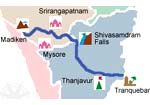


|
|
 |
| HOME | TRAVEL | TRAVELOG | ||

The Call of the Cauvery ... following the course of a river
Bill Aitken
The Ganga of the north seems tired in comparison to the flow of her southern understudy and here the brilliant culture of the South continues to flourish while in the Cow Belt, a golden past has to be dredged up to compensate for the death of any current civic graces. Like the other rivers of the peninsula, the Cauvery flows weakly after the winter rains. Heavy irrigation commitments mean that in the lean season you can pass down much of the river in the delta and hardly see any water in its bed. Upstream, Coorg is a pleasure in all seasons and the people are probably the most friendly constructive and prosperous in the whole of India. The source at Tala Cauvery has always seemed slightly geographically suspicious to me especially when the range in which its rises -- Brahmgiri -- is also applied to the source of the Godaveri. The latter source at Trimbakeshwar is pure priestly fraud for the river does indeed rise in the Brahmagiri hills above.
But the hills of Coorg are bracing and if you climb above Tala Cauvery you might even see the Arabian Sea. Everybody says you can but I've never met anyone who has!. The drive back to Mercara, now Madikeri, is one of the most leafy delights imaginable with the river gaining size from the cluster of hills that lead down to the Mysore plateau. Now broad and brilliantly blue the dammed river at Krishnarajasagar bypasses the elegant town of Mysore, easily India's best kept city, and narrows again to pass through the rocky course of the Ranganatithu bird sanctuary which lies before Tippu's extensive lair, the island fortress of Srirangapatnam. It is fashionable to resurrect Tippu's virtues these days and certainly he was a warrior who might have altered Indian history. But whether for the better is a moot point! His acceptance of atrocities like adult circumcision for forced converts to his faith make his name in Kerala and Mysore a continuing target of revilement.
At T Narsipur the main effluent of the Cauvery joins. This is the lovely Kabini which if explored upstream -- where the borders of Kerala and Tamil Nadu meet Karnataka -- will yield the largest gathering of elephants to be found in India. Sabu the Hollywood elephant boy incidentally hailed from the Maharaja's of Mysore stable hereabouts. Near the confluence is the much-touted temple of Somnathpur. Undoubtedly it is of great architectural and artistic interest but for spiritual uplift it is a very disappointing site. Also its tourist facilities must make this the lousiest place in India to spend a night. Nobody does of course since Mysore -- with the best hotel bargains in the world -- is so close at hand. The river heads now to the Shivasamudram Falls, a lovely fanned out display and probably one of the most aesthetic sights on any Indian river. No doubt the Jog Falls give the Sharavati river magic unsurpassed, but the falls are so deep in their reach that you never see the river below. To show her class the Cauvery leaving Karnataka through a wild and narrow gorge south of Bangalore does a sharp turn into Tamil Nadu to produce more scenic cataracts at Hogganakal. These "smoking stories" announce the end of the untamed river. On the trackless Karnataka shore is the run of forest and hills that harbour the ivory and sandal wood poacher Veerappan. The Mettur dam like the Shivasamdram Falls represents early breakthroughs in river harnessing. At Karu the Cauvery turns west to its delta destiny, receiving water from the Palani Hills which hosts the highest peak in South India -- Anai Mudai -- in Kerala's range of tea estates. Here roams the Nilgiri tahr. How did this mountain goat cross the Palghat gap from the Nilgiris? Up the tributaries of the Cauvery are India's most flourishing textile towns, Tirupur and Coimbatore in the Kongunad uplands. The delta starts in earnest at Tiruchi overlooking the island temple complex of Srirangam. Surprisingly for all its ceremonial gory and architectural style the seven gated "glimpse of heaven" lacks spiritual fireworks. Priests and guides, touts and money changes pester the visitor and for once the orderly instructs of the south is a disadvantages, because you are trapped into the demands of commerce in a place of religion. Similarly at Trichy to climb the Rock Temple you have to buy tickets, extra for camera, though it is true the view of Srirangam from this angle -- minus the priests and cadgers -- is marvellous. The river looks great but look your last upon it because now downstream in the delta it will be channelled for the rich rice crops which are either being sown, irrigated or lying in sheaves upon the road awaiting your vehicle to harvest their round-the-year cycle.
To cover all the temple complexes in the delta region is to invite indigestion, each seeming to outdo the last. Kumbakonam is massive, Gangakondancholam inevitably more so; it was built by a son to outdo his father bid to glory with the Thanjavur Big Temple. Courtesy Sanctuary Features Map by Dominic Xavier
|
|
| Continued | |
|
|
|
|
HOME |
NEWS |
BUSINESS |
CRICKET |
MOVIES |
CHAT
INFOTECH | TRAVEL | LIFE/STYLE | FREEDOM | FEEDBACK |
|